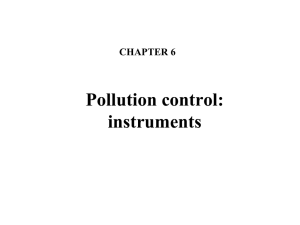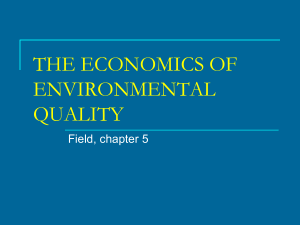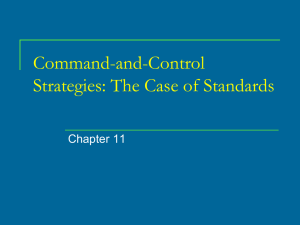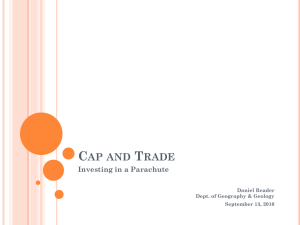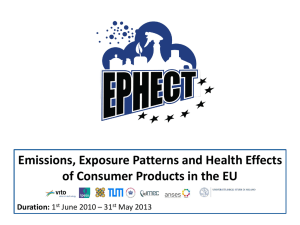Images for Chapter 7
advertisement
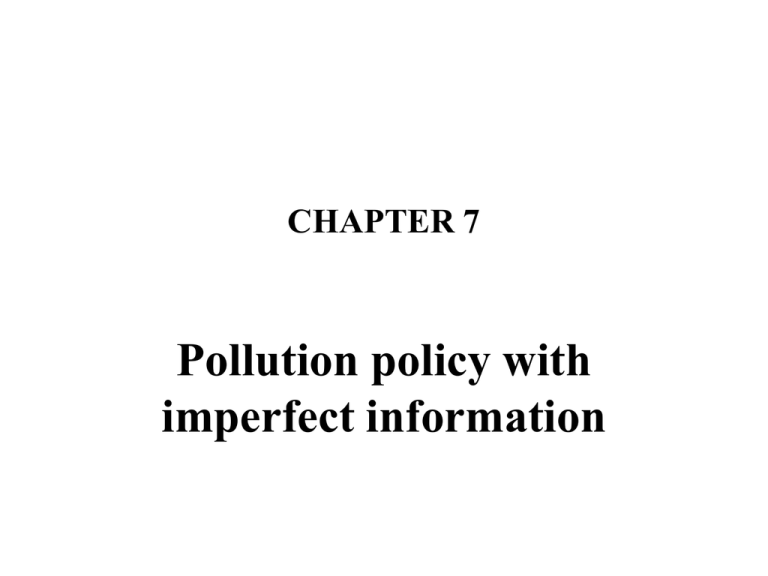
CHAPTER 7 Pollution policy with imperfect information Concepts • Risk and uncertainty: often used to characterise various situations in which less than complete information is available. • Risk: usually taken to mean situations in which some chance process is taking place in which the set of possible outcomes is known and probabilities can be attached to each possible outcome. However, it is not known which possible outcome will occur. • Uncertainty: usually taken to mean situations in which the set of possible outcomes is known but probabilities cannot be attached to each possible outcome. • Radical uncertainty: circumstances in which it would not be possible even to enumerate all the possible outcomes. Difficulties in identifying pollution targets in the context of limited information and uncertainty • Much of the discussion of efficiency-based pollution targets in Chapter 5 implicitly assumed that the policy maker was well informed, and so either knew – or by an investment of resources could discover – the relevant cost and benefit functions. • But this assumption is often not plausible • The environmental agency will often not know with certainty the costs and/or benefits of pollution (or equivalently the costs and benefits of pollution abatement). • Where non-convexities are present, it is not sufficient to know the values of such things near the current position of the economy; they have to be known across the whole range of possibilities. • For stock pollutants, stock effects and spatial considerations imply that the appropriate functions vary from place to place and from time to time. Limited information and uncertainty arises from: • • • The costs involved in acquiring, collating, validating and processing information, implying that census-data are likely to be prohibitively expensive. Sampling error, associated with the use of sampling methods and statistical inference from the sample data. The data collected may not properly represent what the investigator is seeking to obtain. – • Abatement costs: those who possess relevant information may have incentives not to truthfully reveal it. Difficulties in indentifying and evaluating the benefits of pollution abatement (i.e. the benefits of avoided damages). – – Scientific knowledge about pollution impacts is far from complete, and arguably can never be complete because of the stochastic and complex nature of ecosystem functioning. Valuation of environmental services is beset by a host of theoretical and practical problems, and there is little consensus about the validity of current valuation techniques. Some methodological issues • Relevant costs and prices (on both benefit and cost estimation sides) needed for evaluation should be those that correspond to a socially efficient outcome; these may bear little relation to observed costs and prices where the economy is a long way from that optimum. • Difficulties are compounded by ‘second-best’ considerations. • Limited information and uncertainty do not simply mean that decisions should be taken in the same way (but have less ‘accuracy’) as under conditions of full information. Sustainability-based approaches to target setting and the precautionary principle • • • • • • Even taking the perspective of an economist, one would be very reluctant to rely exclusively on efficiency-based targets given the difficulties identified in the previous slides. It seems sensible to at least give some weight to alternative approaches to pollution policy that explicit address limited information and uncertainty. Non-economists are generally suspicious of driving policy on what are perceived as narrowly economic grounds and are critical of the importance that is often attached to efficiency by economists in thinking about pollution targets. Natural scientists, environmentalists and ecologists typically regard stability and resilience as being more fundamental objectives. These objectives – on the one hand, population stability and/or ecosystem resilience, and on the other hand, maximisation of net economic benefits – are not necessarily mutually contradictory. Much of environmental economics (and, more so, ecological economics) consists of an attempted synthesis of the two. Precautionary principle • • In a world of certainty (and so complete predictability) taking precautions would be unnecessary. But in a stochastic or complex environment where outcomes are not certain, where processes are incompletely understood, or where non-linearities of various kinds are thought to exist, some form of ‘playing safe’ is sensible. The precautionary principle – in some of its guises at least – can be thought of as a hybrid criterion. – • Of course, in trying to do several things at the same time, it runs the risk of not doing any of them particularly well. – • It tries to bring together efficiency, sustainability, ethical and ecological principles, into a bundle that can inform target setting. But the approach is now being widely advocated. If efficiency and sustainability criteria yielded identical policy recommendations, their relative importance would not matter. But analysis suggests they do not. Safe Minimum Standard • The precautionary principle can be thought of as proposing a lexicographic approach to setting targets. – – We regard one criterion (in this case sustainability) as being of overriding significance, and require that any target do as well as possible in terms of this measure. If this leaves us with more than one option, then other desirable criteria can be employed (perhaps in a hierarchical way too) to choose among this restricted choice set. • Alternatively, a constraint approach could be adopted: pollution policy should in general be determined using an efficiency criterion, but subject to an overriding sustainability constraint. • • Chapter 13 explains the notion of a safe minimum standard (SMS) of conservation. When applied to pollution policy, the adoption of a strict version of the SMS approach entails that threats to survival of valuable resource systems from pollution flows are eliminated. A modified SMS would eliminate the pollution flow, provided that so doing does not entail ‘excessive cost’. • Taxes Permits t* P* MC M* MC L*(= M*) Emissions, M M PH t* P* MCH MCH PL MC MC MCL MCL ML M* MH M L*(= M*) M Figure 7.1 A comparison of emissions taxes and marketable emissions permits when abatement costs are uncertain Establishing a ‘baseline’ against which the efficiency losses from errors due to uncertainty can be measured. Figure 7.2 Target setting under perfect information MD The efficient target, M*, is that level of emissions which equates the marginal cost of emissions abatement (MC) and the marginal damage of emissions (MD). The shaded area represents the total net social benefit that would be generated at that level of emissions.: the maximum net benefit available. Efficiency losses from uncertainty have in mind are those in which emissions are at any level other than M*, and so attained net benefits fall short of their maximum level. t* MC M* Emissions, M Figure 7.3 Uncertainty about abatement costs – costs overestimated MD Loss when licenses used tH t* MC (assumed) Loss when taxes used MC (true) Mt M* LH Emissions, M Figure 7.4 Uncertainty about abatement costs – costs underestimated MD t* tL MC (true) MC (assumed) LL M* Mt Emissions, M Figure 7.5 Uncertainty about abatement costs – costs overestimated MD MD tH t* MC (assumed) MC (true) Mt M* LH Emissions, M Figure 7.6 Uncertainty about abatement costs – costs underestimated MD MD t* tL MC (true) MC (assumed) LL M* Mt Emissions, M General results for abatement cost uncertainty • What differentiates these two pairs of cases is the relative slopes of the MC and MD functions. We obtain the following general results: 1. When the (absolute value of the) slope of the MC curve is less than the slope of the MD curve, licences are preferred to taxes (as they lead to smaller efficiency losses). 2. When the (absolute value of the) slope of the MC curve is greater than the slope of the MD curve, taxes are preferred to licences (as they lead to smaller efficiency losses). Figure 7.7 Uncertainty about damage costs – damages underestimated MD (true) MD (estimated) t MC (true) M* L Emissions, M Figure 7.8 Consequences of a threshold in the damages function Total D damages M Emissions, M Figure 7.8 (Panel (b)) Marginal The non-linearity in damages implies that a price-based policy has attractive properties where errors are not too large. However, when the estimation error goes just beyond some critical size, the efficiency loss can switch to a very large magnitude. damages & marginal (abatement) costs MD t2 MC1 t1 MC2 M1 M M2 M22 Emissions, M Quantity controls • We leave the reader to explore the use of quantity controls. • You should find that if the EPA set a control at the quantity M1 or M2 (depending on which MC function it deems to be relevant), the likelihood of extremely large efficiency losses is reduced, but at the expense of losing some efficiency for relatively small errors in estimation. • Hartwick and Olewiler conjecture that a best policy in the case analysed in this section is one that combines a tax (price) control and an emissions (quantity) control. • They propose a tax equal to the lower value of the MD function, and an emissions limit equal to the threshold level. The tax bites – and generates efficient emissions – if marginal abatement cost lies in the neighbourhood of MC1. Where MC is sufficiently large to intersect MD in its upper segment, the quantity constraint bites. This composite policy does not eliminate efficiency losses, but it prevents them being excessively large. • The authors argue that such a combined policy is also prudent where uncertainty surrounds the position of the MD function. General conclusions • Where functions are linear, and uncertainty relates to the marginal abatement cost (MC) function, then an EPA should prefer a quantity policy (licences) to an emissions tax if MC is flatter than MD, and an emissions tax to a licence system if the reverse is true, if it wishes to minimise the efficiency losses arising from incorrect information. • However, where uncertainty pertains to the MD function, knowledge of relevant slopes does not contain information that is useful in this way. • Once the existence of non-linearity and/or threshold effects is admitted, general results are harder to find. In some circumstances at least, combined tax–quantity-control programmes may have attractive properties. • The presence of uncertainty substantially weakens the general presumption in favour of incentive-based instruments over quantitative regulations that we developed in the previous chapter. They may be better in some circumstances but not in all. Information requirements: asymmetric information and incentive compatibility • • • • • Imperfect information puts restrictions on the ability of the EPA to devise ‘good’ targets and to attain them at least cost. It also considerably complicates its choice of instrument because comparative advantages depend on the prevailing circumstances. Moreover, limited information and uncertainty may prevent the EPA from knowing which circumstance actually pertains. Faced with all this, there are strong incentives on the EPA to become better informed. One would expect that it would invest in systems that deliver greater information. There are three ways that the EPA might do this: 1. undertake its own research to gather data; 2. build long-term institutional relationships with regulated businesses; 3. create reward structures that give firms incentives to reveal information truthfully to the regulator. Incentive compatibility • An instrument is incentive-compatible if the incentives faced by those to whom the instrument applies generate behaviour compatible with the objectives of the regulator. • In general, none of the instruments we have discussed so far has this property. Where polluters think that the numbers they report can influence the severity of regulation, they have an incentive to lie about the costs of complying with abatement targets. • This is true whether the instrument being used is command and control, emissions tax, abatement subsidy or a marketable permit scheme. • We illustrate two examples of such incentive effects. – – • If firms expect tax schemes to be used they have an incentive to understate abatement costs. If they expect a marketable permit scheme, the incentive is to overstate these costs. We also outline one possible instrument – a mixture of abatement subsidy and marketable permits – that is incentive-compatible. Figure 7.9(a) Incentive effects with permit systems MD P1 * P2 MC (reported) If firms honestly report their actual abatement costs, L* permits are issued, allowing an efficient emissions level M*. In a competitive permits market the equilibrium permit price would be μ*. If firms overstate their abatement costs, the EPA incorrectly believes that the efficient target is MP, and so issues that number of permits (LP). Exaggerating abatement costs is better for firms than being truthful as more permits are issued, and so they incur lower real emission abatement costs. MC (true) M* MP =L* =LP Emissions, M With an emissions tax, firms have an incentive to understate their abatement costs. Figure 7.9(b) Incentive effects with an emissions tax MD Firms benefit because they emit more than if they told the truth (and so incur lower real abatement costs). Also, the tax rate is lower than it would be otherwise. * T MC (true) MC (reported) MT2 M* MT1 Emissions, M An incentive-compatible instrument: Kwerel (1977) • Can an instrument be found which will encourage truthful behaviour and allow the EPA to achieve its objective? • We are looking for an instrument that creates an incentive to report abatement costs truthfully and which allows the EPA to achieve whatever target it wants in a cost-effective way. • Several schemes with such properties have been identified. One is proposed by Kwerel (1977). • The scheme involves a combination of marketable permits and subsidies on ‘excess’ emissions reduction. Intuition • The scheme involves a combination of marketable permits and subsidies on ‘excess’ emissions reduction. • The costs that firms report have two effects: 1. they influence the number of permits issued 2. they also influence the subsidy received for excess emissions reduction. • The scheme balances these two influences so as to reward truthful reporting. Mechanism Kwerel’s scheme works in the following way. Firms are told that: 1. permits will be allocated through auction; 2. they will receive a subsidy for any emissions reduction over and above the number of permits they hold; 3. the subsidy rate will be set at the intersection of the marginal damage curve and the reported marginal abatement cost curve. • Given this information, firms are then asked to report their abatement costs, the subsidy is set accordingly, and the permit auction takes place. • The total cost of the scheme to all firms in the industry is equal to actual emission abatement cost plus the cost of acquiring permits less the subsidy payments received on any emissions reduction over and above the permitted amount of emissions. Notation • We use the following notation: M = volume of emissions; L = number of permits made available to industry; P = price of permits; s = subsidy per unit of emissions reduction. • Then we can write an expression for pollution abatement costs (PCC) for the whole industry. PCC = Abatement costs (area under MC curve) + Permit costs P • L Emissions reduction subsidy s • (L - M) • To demonstrate that this instrument is incentive-compatible, we compare the benefits to firms of being truthful with the benefits of (a) understating costs and (b) exaggerating costs. Figure 7.10(a) An incentive compatible instrument and under-reporting costs MD P P* s MC (true) MC (reported) M L M*= L* Emissions, M Figure 7.10(b) An incentive compatible instrument and over-reporting costs Diagram shows the losses that firms make as a result of exaggerating abatement costs. The shaded area is the additional abatement costs, the hatched area is the additional price paid for permits. It can be seen that as MC (reported) goes towards MC (true), these losses disappear. The best that the firm can do is to be truthful! MD s MC (reported) P* MC (true) M M* L Emissions, M Transactions costs and environmental regulation • In carrying out its responsibilities, an environmental protection agency necessarily incurs transaction costs. This is a generic term for a variety of costs that include: – – – – – • • • • • acquiring relevant information; creating, monitoring and enforcing contracts (of which one category is the EPA’s regulations); establishing, implementing and revising the instruments it employs; monitoring performance, and ensuring compliance. Transactions costs do include the costs of the personnel and the structures an organisation puts in place that allow it to carry out its activities, and any equivalent costs imposed on other parties, including the regulated firms or individuals. They do not include what are sometimes called the real resource costs of the controls – that is, the costs of pollution control equipment, higher fuel bills for cleaner fuel, more expensive exhaust systems and so on. They also do not include any induced indirect costs that might occur such as loss of national competitiveness or increased unemployment. Summing up all those costs gives the total compliance costs of environmental regulation. Transactions costs are just one part – often a not insignificant part – of that overall total. Figure 7.11 The net benefits of regulation Marginal real resource cost of abatement + induced indirect costs + transactions costs Marginal real resource cost of abatement + induced indirect costs D Marginal real resource cost of abatement C Gross marginal benefits of abatement B A ZC ZB ZA Emissions abatement

